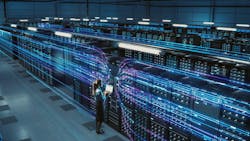A new year is in full swing, and with it brought the next wave of enterprise growth, innovation and transformation. In the dynamic world of digital infrastructure, data centers require the ability to react quickly while staying ahead of advancements in technology, market trends and new opportunities—and it’s no small feat.
Hearing from seasoned industry leaders on what’s happening behind the scenes in the ever-evolving enterprise IT realm and what to expect next sparks compelling conversations and progressive ways of thinking to help further strengthen the data center industry’s agility while reaching new heights and enabling innovative strategies for the enterprise of the future.
Just days into 2024, Involta, a Carlyle portfolio company and national provider of enterprise-class data center, cloud and connectivity infrastructure and services, focused on healthcare, manufacturing, financial services and high-tech organizations, announced the appointment of Brett Lindsey as CEO to lead its future growth across key markets and industries.
With decades of experience in the telecommunications industry leading significant transformation and cultivating inspiring company culture and notable philanthropy efforts, Brett shares his thoughts on the most significant topics facing the digital infrastructure ecosystem and how they will shape progress for enterprises in the years ahead in this exclusive Q&A.
Q: When it comes to the rapid emergence of new technologies and evolving enterprise requirements, especially in mission-critical verticals, how are data centers keeping pace while maintaining an eye on the future?
A: Data centers today have to be agile. They have to go beyond space and power to meet not only today’s industry demands but also future requirements—all while remaining environmentally responsible.
The industry is seeing a significant demand for edge solutions. Being able to keep pace by expanding to support HPC and growing IT workloads will be vital to progress. Honing in on enterprise colocation needs in tech-focused industries, such as manufacturing, healthcare and financial services, is also critical. For example, in healthcare, the adoption of IoT devices for patient monitoring and diagnostics is increasing. Data centers are incorporating edge computing to process and analyze data closer to the source to reduce latency. Colocation facilities situated strategically can provide low-latency access to healthcare institutions.
Additionally, the protection of private data emerges as a paramount concern for enterprises dealing with highly sensitive information. In the financial services sector, organizations seek data center partners capable of implementing robust cybersecurity measures, such as encryption and ongoing compliance. This emphasis on security is expected to drive an increased interest in private cloud environments as institutions prioritize secure networks and storage solutions to ensure 100% data integrity. As the industry evolves, these considerations underscore the multifaceted approach data centers are taking to meet the diverse and evolving needs of enterprises across different sectors.
Q: That leads us to the critical question around balancing sustainability and the ever-increasing amounts of power and computing capacity. What modern strategies are being used to enable high-performance computing while assuring enterprises meet sustainability targets?
A: Sustainability within the industry is critical, especially as the need for faster, greater computing power rises. We are already seeing tremendous innovation in energy efficiency, waste reduction, emissions tracking and new ways to repurpose waste heat. For example, direct liquid cooling (DLC) is a gamechanger in the management of IT equipment and rack temperatures. By leveraging convection, DLC technology is much more efficient than traditional air cooling methods. With DLC in place, Involta is able to improve PUE, operating at a higher capacity and achieving more energy-efficient operations.
Another way to optimize PUE is to invest in renewable energy, such as wind, solar and geothermal. According to the Uptime Institute, renewable energy currently accounts for 23% of the total power consumed by data centers worldwide. By leveraging renewables, data centers can further increase this percentage and pave the way for a more sustainable industry.
Q: Cyber and network security have never been more prevalent. From sensitive healthcare data to private financial information, enterprise security plans need to be ironclad. How will the IT landscape continue to improve its posture to mitigate costly sophisticated attacks?
A: Consideration of security and compliance is paramount in our industry. To stay ahead of sophisticated breaches and threats, developing and executing a strategic cybersecurity plan must be the top priority. In 2024, I expect to see continued adoption of zero-trust security models, multi-factor and biometric authentication solutions and data backups. More enterprises will look to leverage the expertise of managed cybersecurity providers to implement robust employee training, disaster recovery and compliance requirements, especially across industries such as healthcare, manufacturing and financial services. Certifications like HI TRUST and NIST are often too cumbersome for many enterprise and mid-market companies to handle internally, so partnering with a knowledgeable data center operator who understands complex regulatory requirements will be critical.
There will also be a need for expanded and improved managed security services. Around-the-clock monitoring and analysis of the security posture for enterprises will require a combination of supported security toolsets, incident response and operational processes to keep mission-critical assets secure.
Q: What U.S. markets do you see becoming more attractive to enterprises in the year ahead?
A: The uptick in enterprise colocation and edge, spurred by AI, cloud-native applications, IoT and other latency-sensitive applications, is drawing more attention to Tier 2 markets throughout the country. Green Bay, Wisconsin, for example, with its close proximity to Chicago, a Tier 1 market, is a prime target for data center expansion to support the rapidly growing needs and performance requirements of high-tech industries, particularly manufacturing.
Energy-efficient data centers in Tier 2 markets also bring robust, redundant fiber infrastructure to surrounding areas, driving more connectivity locally and regionally. The expansion into secondary markets will continue to become more essential as data processing power will be needed close to the point of use to support AI and IoT, while still having access to Tier 1 markets. For example, more local enterprises and healthcare and manufacturing organizations are seeking high-performance and secure digital infrastructure solutions in Tucson. Seventy percent of Arizona Commerce Authority pipeline projects are manufacturing related, meaning the state will require more data center capacity to support its evolution into a designated manufacturing hub. Tucson’s proximity to Phoenix, one of the largest data center and tech markets in the U.S., also allows enterprises to expand their reach in a less-saturated secondary market while leveraging all that the nearby Tier 1 market has to offer.
Internet exchanges within secondary markets are also on the rise. Internet exchanges offer several benefits, including improved local connectivity and collaboration and greater network redundancy and resilience. Enterprises will continue to turn to hybrid IT models to support their rapidly evolving needs and look for partners who are able to effectively reshape data distribution, optimize resource utilization and deliver more efficiency—a growing shift to be on the lookout for in the new year.
Q: Philanthropy initiatives help empower the next generation and upskill current talent within tech-related industries. How do you view these initiatives?
A: Philanthropy, empowering the next generation and upskilling current employees are important ways to contribute to the holistic success of the industry and build a tremendous culture. As a company, philanthropy and investing in social causes allows us to strengthen our bond with the community and create a positive impact within our industry, internally and beyond. Same can be said for investing in educational programs, scholarships and partnerships with schools and universities to empower the next generation of tech-minded individuals. Equally important, upskilling current talent is essential in ensuring that our workforce remains adaptable and innovative. Internal training and development programs that are less about enhancing skills and more about fostering a culture of employee growth is a strategy Involta has implemented. This approach has led to higher job satisfaction, retention and a workforce that is invested in the success of the company and industry overall.
Technology is evolving rapidly and the data center industry must follow suit. The next evolution of enterprise IT is here. As advancements in AI and IoT take hold and the need for greater computing capacity grows, data centers are essential hubs of connectivity, and they will be the key to powering our data-driven world efficiently and effectively.

Brett Lindsey
Brett Lindsey is the Chief Executive Officer of ark data centers (formerly Involta), a Carlyle portfolio company and prominent national provider of data center, cloud and connectivity infrastructure and services. He has navigated the dynamic landscape of the telecommunications industry for three decades, demonstrating consistent growth, measurable outcomes and significant financial performance. Lindsey joins ark data centers after serving as the CEO of Everstream for eight years. He propelled Everstream’s growth from a Cleveland-only fiber network to a leading provider with a 10-state presence serving enterprise and hyperscale clients – solidifying the company’s role as a key player in the Midwest and Mid-Atlantic fiber network industry. In previous telecommunications infrastructure roles, Lindsey has demonstrated entrepreneurial prowess, operational excellence and a commitment to community through multiple acquisitions and exits, federal grant awards and metro fiber expansions.






